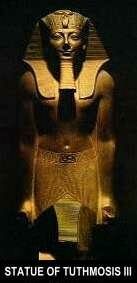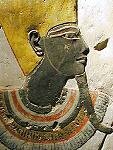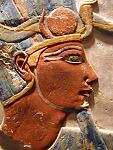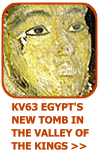|
|
|

Pharaoh profiles: Akhenaten | Alexander the Great | Cleopatra VII | Hatshepsut | Ramesses the Great | Tutankhamun | Tuthmosis III
The "Napoleon" of Ancient Egypt (throne name Men-kheper-re).
 After the death (or removal) of his stepmother Hatshepsut, Tuthmosis III finally claimed his rightful inheritance of the throne of Egypt. During Hatshepsut's revolutionary reign, Tuthmosis III had been kept well in the background. A keen and successful military campaigner, it is now a considered possiblity that he spent a lot of this time "away" with the army. After the death (or removal) of his stepmother Hatshepsut, Tuthmosis III finally claimed his rightful inheritance of the throne of Egypt. During Hatshepsut's revolutionary reign, Tuthmosis III had been kept well in the background. A keen and successful military campaigner, it is now a considered possiblity that he spent a lot of this time "away" with the army.
To further complicate the already confusing family tree, Tuthmosis was married to Neferure, who was the daughter of Hatshepsut and Tuthmosis II. However, Neferure had died (or disappeared?) before Tuthmosis finally succeeded the throne, which meant that he was a widower when he actually became king. He then married Hatshepsut-Merytre as his principal queen, who was to be the mother of his heir, Amenhotep II.
Egyptian control of various city-states in the Syria-Palestine and Lebanon regions had slipped during the reign of Hatshepsut. Several local princes had transferred their allegiance from Egypt to the Kingdom of Mitanni, one of Egypt's most powerful rivals in western Asia. However, Tuthmosis III was to "set the record straight" with these city-states within the first two years of his independent reign.
Tuthmosis's military campaigns
Famous for his many successful military campaigns, Tuthmosis has earnt himself the nickname of the "Napoleon of Ancient Egypt" with some modern day egyptologists. Some of his biggest victories came against the Mitannian empire. He captured and gained control of many Mitannian territories, which expanded his power over northern Palestine and Phoenicia. He erected a stele at he Euphrates River to mark the boundary of the Egyptian Empire.
| In the second year of his reign, Tuthmosis began his Near Eastern campaign. This proved to be a masterpiece of planning, skill and nerve. In under five months, he had travelled from Thebes right up the Syrian coast, captured three cities, and returned to celebrate his victories. Tuthmosis launched campaigns into Syria-Palestine every summer for the next 18 years, finally capturing Kadesh. The Lists at Karnak detail over 350 cities that fell to the mighty troops of Ancient Egypt. |
|
Apart from the 17 campaigns into Syria-Palestine, the king also mounted small expeditions into Nubia, building temples at Amada and Semna. Many temples were enriched, embellished and extended from the spoils of war, in particular, the temple of Karnak. A great black granite "Victory Stelae" from Karnak records how the "king smote all before him". Pylon 7 records his successful military campaigns, and shows the king in the ever popular style of Pharaoh smiting his enemies. |
Will we ever know the truth about Hatshepsut and Tuthmosis III?
 It was originally believed that Tuthmosis III had waged a vengeful war on his stepmother's monuments when he had finally became pharaoh in his own right. After the death or removal of Hatshepsut, many reliefs at her mortuary temple at Deir el-Bahri were badly damaged, and statues were smashed. Even the tombs of Tuthmosis's stepmother's courtiers suffered attacks. Hatshepsut's obelisks, which had been brought from Aswan to Karnak were walled up and their inscriptions hidden. Ironically this preserved them in excellent condition, and they have since been revealed once again. It was originally believed that Tuthmosis III had waged a vengeful war on his stepmother's monuments when he had finally became pharaoh in his own right. After the death or removal of Hatshepsut, many reliefs at her mortuary temple at Deir el-Bahri were badly damaged, and statues were smashed. Even the tombs of Tuthmosis's stepmother's courtiers suffered attacks. Hatshepsut's obelisks, which had been brought from Aswan to Karnak were walled up and their inscriptions hidden. Ironically this preserved them in excellent condition, and they have since been revealed once again.
However, it is now thought more along the lines that the monuments were not actually defaced until many years later. This of course, raises the questions:
|
Was the motive for the destruction and defacement of the monuments pure vengeance and anger on the part of Tuthmosis III, or possibly more of a feeling that Hatshepsut's reign had simply been contrary to tradition? This "break from tradition" may have also been the reason why she was omitted from subsequent King Lists, in the same way that Akhenaten, Smenkhkare and Tutankhamun were.
|
|
|
Why would such a great military campaigner such as Tuthmosis III, who achieved so much during his reign, seemingly allow his so called "hated" stepmother to rule for such a significant number of years when the throne should have rightfully been his in the first place?
|
 It is by no means clear as to whether Hatshepsut simply died, and Tuthmosis III then became sole ruler, or whether she was forcibly removed. Senemut, Hatshepsut's architect, chief courtier and tutor to her daughter Neferure was not mentioned after Tuthmosis's 19th regnal year. It is possible that Senemut's political skills had helped Hatshepsut to gain her elevated position, and that his disappearance may have eased the transfer of power to Tuthmosis III. It is by no means clear as to whether Hatshepsut simply died, and Tuthmosis III then became sole ruler, or whether she was forcibly removed. Senemut, Hatshepsut's architect, chief courtier and tutor to her daughter Neferure was not mentioned after Tuthmosis's 19th regnal year. It is possible that Senemut's political skills had helped Hatshepsut to gain her elevated position, and that his disappearance may have eased the transfer of power to Tuthmosis III.
Perhaps one day, the true complexities of this relationship will finally be discovered!
IMPORTANT NOTE: The precise dates of the Egyptian Dynasties and of individual reigns are still the subject of much scholarly debate. Students and other individuals who use this website should therefore be aware that the dates shown for the dynasties and individual reigns throughout this site may sometimes differ to the dates that are used in other publications.
|
|
|









 After the death (or removal) of his stepmother Hatshepsut, Tuthmosis III finally claimed his rightful inheritance of the throne of Egypt. During Hatshepsut's revolutionary reign, Tuthmosis III had been kept well in the background. A keen and successful military campaigner, it is now a considered possiblity that he spent a lot of this time "away" with the army.
After the death (or removal) of his stepmother Hatshepsut, Tuthmosis III finally claimed his rightful inheritance of the throne of Egypt. During Hatshepsut's revolutionary reign, Tuthmosis III had been kept well in the background. A keen and successful military campaigner, it is now a considered possiblity that he spent a lot of this time "away" with the army. It was originally believed that Tuthmosis III had waged a vengeful war on his stepmother's monuments when he had finally became pharaoh in his own right. After the death or removal of Hatshepsut, many reliefs at her mortuary temple at Deir el-Bahri were badly damaged, and statues were smashed. Even the tombs of Tuthmosis's stepmother's courtiers suffered attacks. Hatshepsut's obelisks, which had been brought from Aswan to Karnak were walled up and their inscriptions hidden. Ironically this preserved them in excellent condition, and they have since been revealed once again.
It was originally believed that Tuthmosis III had waged a vengeful war on his stepmother's monuments when he had finally became pharaoh in his own right. After the death or removal of Hatshepsut, many reliefs at her mortuary temple at Deir el-Bahri were badly damaged, and statues were smashed. Even the tombs of Tuthmosis's stepmother's courtiers suffered attacks. Hatshepsut's obelisks, which had been brought from Aswan to Karnak were walled up and their inscriptions hidden. Ironically this preserved them in excellent condition, and they have since been revealed once again. It is by no means clear as to whether Hatshepsut simply died, and Tuthmosis III then became sole ruler, or whether she was forcibly removed. Senemut, Hatshepsut's architect, chief courtier and tutor to her daughter Neferure was not mentioned after Tuthmosis's 19th regnal year. It is possible that Senemut's political skills had helped Hatshepsut to gain her elevated position, and that his disappearance may have eased the transfer of power to Tuthmosis III.
It is by no means clear as to whether Hatshepsut simply died, and Tuthmosis III then became sole ruler, or whether she was forcibly removed. Senemut, Hatshepsut's architect, chief courtier and tutor to her daughter Neferure was not mentioned after Tuthmosis's 19th regnal year. It is possible that Senemut's political skills had helped Hatshepsut to gain her elevated position, and that his disappearance may have eased the transfer of power to Tuthmosis III.